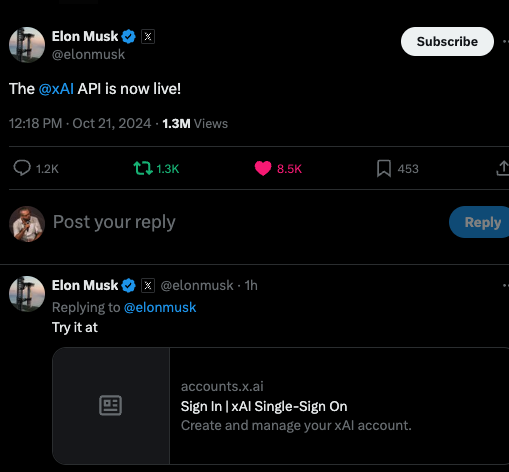Join our daily and weekly newsletters for the latest updates and exclusive content on industry-leading AI coverage. Learn More
Elon Musk has been making headlines recently for his political activities and rocket launches, but that hasn’t stopped the six-company owner/operator from moving forward with xAI, his artificial intelligence startup.
Today, Musk announced via his social network X (formerly Twitter) that xAI now offers an application programming interface (API) that third-party developers can now use to access and build applications and features powered by xAI’s Grok large language models.
Musk posted a simple message on his X account, “The @xAI API is now live!” around 12 pm ET on Monday, October 21, following up with a reply post that included a link to the xAI API sign-on page.

According to xAI’s documentation, its API give developers access to Grok-2 and Grok-2 mini, xAI’s latest multimodal language models, which also include the capability to generate permissive images with Black Forest Labs’ Flux.1 diffusion model.
However, in my limited test of it, I was only able to access a model named “Grok-beta.” Notably, the entire API website is labeled at the top as a “public beta,” so presumably the xAI developers and engineers will be working out various bugs and adding new features in the coming days.
Positioning and pricing
Releasing the xAI API is helpful for xAI and Musk’s greater quest to go head-to-head against his former company OpenAI (which he co-founded and left), which offers an API as well.
The xAI API offers a web-based console for creating API keys, exploring endpoints, and integrating models into applications.
It supports REST, gRPC, and SDKs, and is compatible with other AI services such as OpenAI, enabling smooth integration with existing systems.
I signed up to check out the pricing and spent $25 on prepaid credits to see if I could get access to the models, but was only able to access “grok-beta” at the time of this article’s publication.
It provides 131,072 tokens of context, and the API can handle 1 request per second (RPS) and up to 10 requests per minute (RPM).
For now, OpenAI’s pricing for its AI models is largely cheaper than xAI’s, with GPT-4o costing developers $2.50 per 1 million input tokens/$10 per 1 million output tokens, versus Grok’s $5 per million input/$15 per output (though OpenAI’s new reasoning model o1 is more expensive than both at $15/$60).

• Text and Code Generation: The Grok models can handle tasks like generating code, summarizing content, and performing data extraction. This flexibility makes them valuable for a wide range of use cases, including software development and data analysis.
• Vision: The models can analyze and generate images, expanding their use beyond text-based tasks to multimedia and visual content generation.
• Function Calling: The xAI API allows models to interact with external tools, such as APIs and databases. This enables real-world tasks like booking a flight, accessing IoT devices (e.g., unlocking a Tesla), or fetching live data from websites.
New dev features
Toby Pohlen, a founding member of xAI, shared additional details about building the new xAI API in a thread on the social network X today, writing, “Creating a scalable API from scratch was a massive effort. Here are some of my favourite engineering highlights.”

As he explained, xAI’s API includes:
• Usage Explorer: The xAI Console includes a usage explorer that tracks API consumption, similar to what’s found in major cloud provider platforms, giving developers insights into their resource usage and costs.
• Simplified Team Management: Small businesses can bind an email domain to their teams, making it easier to manage users and teams in the platform.
• Enhanced Security: Users can view all active sessions in the account app, and log out of any unrecognized devices. In addition, every time the account is accessed from a new IP address, the user is notified by email.
The platform also supports two-factor authentication via TouchID, security keys (e.g., Yubikey), and authenticator apps.
How to get started with xAI’s new API
To begin using the xAI API, developers must sign up via the xAI Console, onboard their teams, and configure billing.
Each team is assigned its own API keys and billing setup, ensuring that enterprises can track costs and manage resources effectively.
As Pohlen highlighted, team management is streamlined for smaller companies through the ability to bind an email domain to their teams.
Whether devs flock to xAI’s API and adopt it alongside or in place of other compelling alternatives in the gen AI age such as OpenAI, Anthropic, Google, Microsoft, and more, remains to be seen. But at least, now xAI is giving them the option.
 [ad_2]
[ad_2]

